It is essential to know about Node.js when building decentralized applications, or dApps. As such, we’ll delve into all the details of Node.js, as well as how you can use it in conjunction with Moralis. If you want to learn more about all the opportunities that arise from smart contract-driven dApps and the advent of Web3, be sure to check out the extensive materials readily available on the Moralis blog and official YouTube channel. In short, Node.js is a programming platform released in 2009 to help manage some of the complexities of JavaScript. It is uniquely suitable for Web development in the age of blockchain.
Specifically, with scalability an ever-growing challenge in this global industry, Node.js gives developers at dApp platforms like Moralis the ability to create high-performing, scalable network applications. Let’s do a deep dive to answer all the important questions including, what is Node.js, what is Node.js used for, and what are its main features? Read on to get the full breakdown of Node.js, its features, as well as how you can use it with Moralis. As you’ll know, Moralis is a next-gen development platform that acts as middleware when building with blockchain.
What is Node.js and why is it important?
Built on Chrome’s JavaScript runtime, Node.js makes it easier for developers to build scalable, high-performance apps. Also referred to simply as “Node”, it is is a framework that has important characteristics:
- It uses an event-driven, non-blocking I/O model. This means that the node process doesn’t lock up the entire web app when retrieving a sole response. It merely moves on to the next event and continually runs until the event queue is empty. Node.js introduces an event model that uses an event loop as a runtime construct, not just a library. This eliminates the need for a blocking call to start an event loop. In this way, it provides a framework that is lightweight, efficient, and highly suited for real-time applications across distributed networks.
- Node.js enhances the use of JavaScript by running both on the client as well as the server-side. It allows web applications to run with real-time two-way connections where both server and client can initiate communications and freely exchange data.
- Developers who run JavaScript-heavy applications benefit from the ability to reuse code without the added burden of context switching between edit and search tools. Node.js packing manager (NPM) is known for code reuse, with over a million packages for developers to use in programming tasks.
Armed with these features, Node.js fits in perfectly with the open-source environment of blockchain development. With public blockchains, real-time data exchange and communication are essential. So is the need for bridges to maintain interoperability with other blockchain-based platforms. It represents yet another advancement as web development evolves to the Web3 environment.

Components of Node.js framework
The components that make up the Node.js framework are the following:
- Google’s v8 JavaScript open-source engine, which runs on iOS, Linux, and Windows.
- The libuv cross-platform platform abstraction layer, which supports asynchronous I/O based on event loops.
- A core library that is written in JavaScript.
As its creator Ryan Dahl described it, Node.js is an “evented I/O for v8 javascript”. Developers across the globe use his innovation when building real-time websites. Both the client and the server can initiate communication, allowing them to exchange data freely. Previously, a typical web response would only allow the client to initiate communication.
What is Node.js used for?
One of the easiest ways to determine “What is Node.js used for” involves discussing some of the problems that Node.js solves for developers. Then we’ll review some of the applications developers can build using this framework.
One significant challenge that Node.js addresses is the inefficiency of OS threads. Let’s take a simple example using a “hello world” configuration written using Node.js as pictured below to see how this manifests.
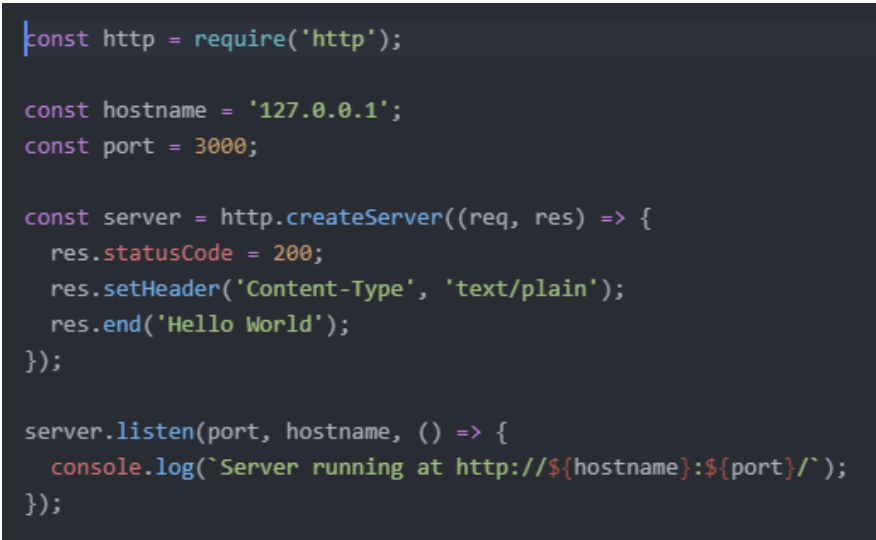
In the “hello world” example, many connections can be handled concurrently. Upon each connection, the callback is fired, but if there is no work to be done, Node.js will sleep.
As an asynchronous framework, it doesn’t wait for file I/O to complete. Instead, it uses callbacks, which are functions called when a given task is complete. Callbacks help to prevent blocking while allowing other code to run in the meantime. They contrast with OS threads, which are tricky to use and not as efficient. Node.js users benefit from using a framework with no locks, as functions do not perform I/O, eliminating the process of dead-locking.
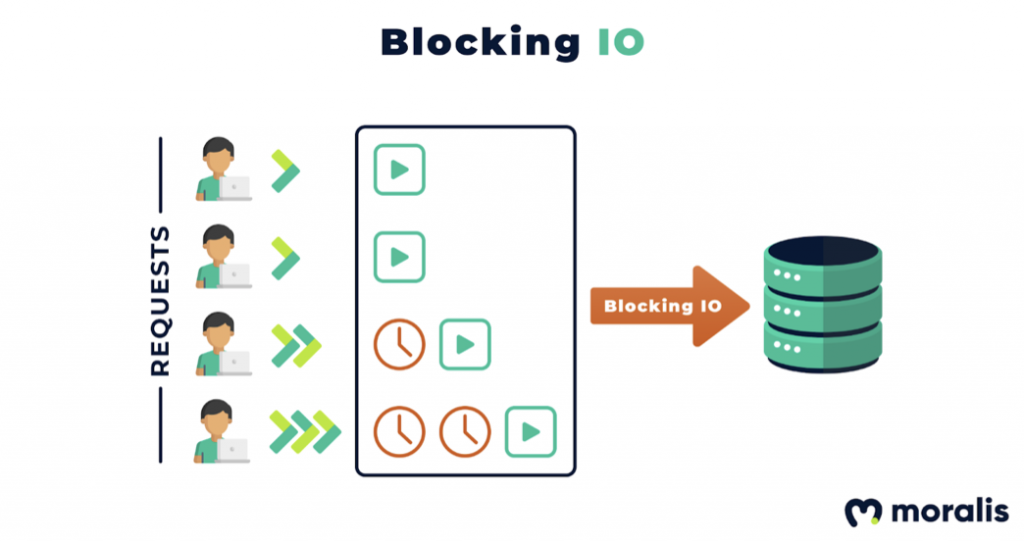
With the callback system in place, developers are free from blocks while building scalable systems is easier and faster.
Addressing the complexities of JavaScript
The Node.js platform supports the CommonJS standard, which enables modularized development. In this system, software is distributed in packages through a Node Package Manager, or NPM. The NPM acts as an online repository where developers can publish open-source code. It also provides a command-line utility for connecting with the repository for installation purposes and version updates.
Before the introduction of Node.js, an app’s behavior was dependent on callbacks at the start of the script, while at the end a server starts through a blocking call. With it, the event loop start call is not necessary because it just enters the event loop after the input script executes. Then it exits the event loop whenever there are no more callbacks. All the while, the event loop is hidden on the user end.
Recap
Let’s take a quick breather and review:
What is Node.js?
- Node.js is an open-source runtime environment.
- It is useful in building server-side networking apps.
- JavaScript is its language
- Node.js can run on OS, Windows, or Linux.
- With the framework comes a deep library of JavaScript modules making the work of app development simpler and faster.
- Enables applications with real-time 2-way connections and the free exchange of data.
Features of Node.js
- Event-Driven, or Asynchronous – The APIs from the Node.js library are asynchronous, or non-blocking. A server moves right to the next API and doesn’t wait for the API to communicate back.
- Speed – By using Google Chrome’s V8 JavaScript Engine, it enables fast code execution.
- Single-Threaded – A single-threaded model utilizes event looping, which is a much more scalable system. The event mechanism enables a response from the server without blocking. Traditional servers entail limited threads. In this way, a server can service many more requests.
What is Node.js used for?
- Addressing the complexities of JavaScript
- Enabling modulated development
Main advantages of Node.js
As you have already learned, there are many advantages to using the Node.js software development platform. So what is Node.js good for? We’ve seen some of the specifics, now let’s look at the big picture. What does using it mean for developers and the end users that download their applications?
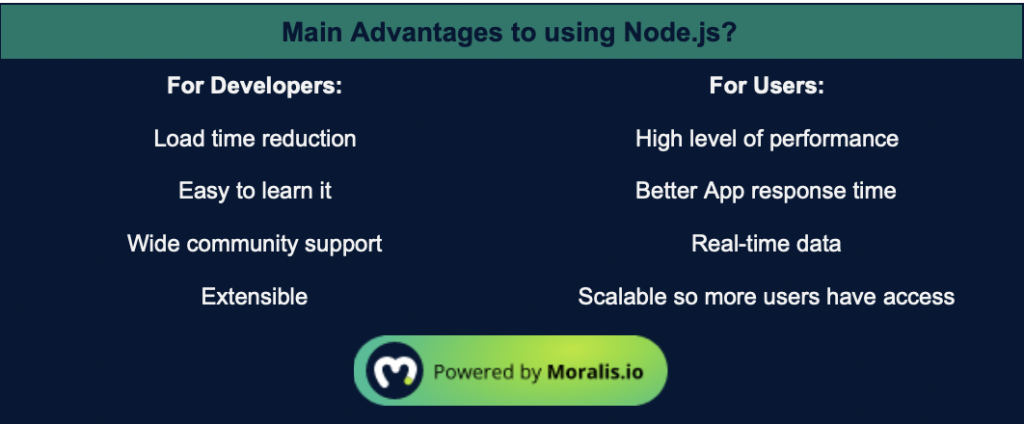
When answering the question, “What is Node.js good for”, it comes down to making a developer’s work quicker and easier. This is partly why Moralis is such a good match for it, seeing as Moralis also supercharges your development process. In fact, Moralis’ fully managed blockchain backend infrastructure allows you to deploy dApps in minutes rather than days.
What types of applications is Node.js used for?
Now we’re getting to the good stuff. What kind of applications and functionalities can developers build using Node.js? Below we’ve compiled a list of the main types of applications, each with a real-world example:
- Data Streaming Applications such as real-time stock trades
- Data-Intensive Real-time Applications (DIRT) such as image processing and web crawling
- JSON APIs-based Applications for data transmittance in web apps, i.e. for displaying a web page
- Single Page Applications such as Google Maps and Netflix
- Static file servers for transmitting videos or images
- Web Application frameworks such as Socket.io for chat apps
- Servers for HTML5 multiplayer games
What is Node.js Not Used for?
Although this is ultimately up to you, it is generally not advisable to use it for CPU-intensive applications such as transcoding tasks or video editing.
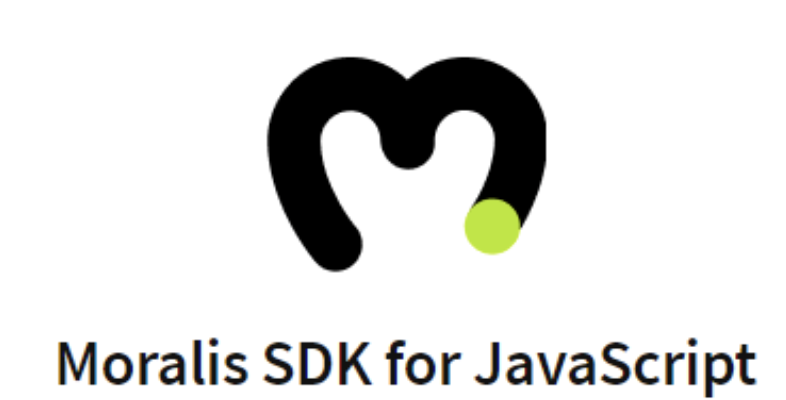
Remember that Moralis provides all the tools developers need to build high-performing dApps. Our NPM module has specific versions of its Software Development Kit (SDK) that are designed for using Node.js.

What is a Node.js server?
As you’ve learned by now, Node.js features a runtime environment that uses Chrome’s v8 JavaScript engine. It also includes an HTTP-compatible module that includes all the functions and classes necessary for building an HTTP server.
The Node.js Community
Node.js has a wide global community surrounding it. There are many levels of participation, which are broken down below:
Collaborators
The Collaborators maintain the GitHub repository for Node.js. They are a part of the Technical Steering Committee (TSC), which services the consensus process on an ongoing basis. Developers who make important contributions become Collaborators and are granted commit access to the project.
Top Level Committees
The TSC governs the Node.js project along with the Community Committee (CommComm). TSC is more for high-level guidance while CommComm generally guides the surrounding community.
CommComm also has authority over outreach efforts such as education initiatives, community outreach, project moderation, and translation. The Community Committee has four branches within itself:
- The Contributor can create, comment, and issue a pull request.
- A Collaborator is essentially a Contributor with write access to the Github repository.
- An Observer is simply a person who has requested or been invited to attend a CommComm meeting. This usually is the first step in becoming a Member.
- The Member is a Collaborator who has voting rights. They have met all the requirements for participating and the CommComm must vote them in.
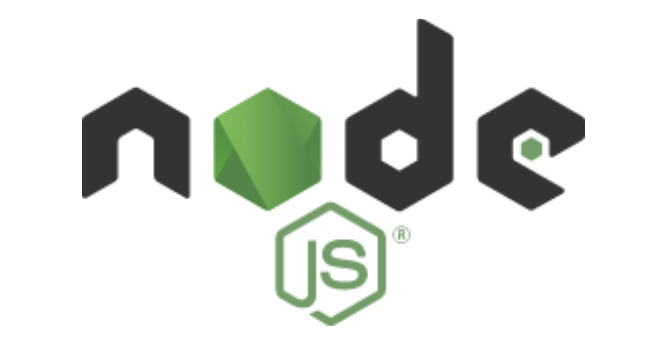
Consensus-Seeking Process
Node.js uses a consensus-seeking model for its decision process. As each agenda item appears to reach consensus, a moderator asks if any of the collaborators object. If consensus still cannot be reached and as long as there are no additional objections, the agenda item goes to a “majority vote wins” system. Generally, voting is the last resort action and usually not necessary.
Other developer participants can join in the efforts to support the larger Node.js community. Localization, evangelism, and working on the Node.js Collection are examples of how to become a part of the community.
How Moralis Fits In
Moralis is quickly establishing itself as the leading middleware for quickly building cross-chain blockchain applications. That is why developers will definitely want to join the community and utilize their Node.js and other web development skills. At Moralis, you will have all the tools you need to build out the next generation of dApps and serverless apps. We are creating the future Internet. We hope you are ready to join us!
Recap
- What is Node.js? – As a programming framework released in 2009, Node.js solves some of the complexities of the JavaScript programming language. It is particularly useful in helping developers build fast, scalable applications.
- What are its main features? – Node.js runs on Google v8 JavaScript engine for speed. Its core library is written in JavaScript. It utilizes an Event Driver or Asynchronous system, which is non-blocking and enables 2-way data sharing.
- What is Node.js used for? – Developers use it to help build high-performance apps with faster response times and real-time data.
- Why should Developers get involved? – It is simple to learn, has wide community support, and is open-source with many easy-to-use, time-saving modules.
From building single-page applications to running data-intensive real-time dApps, Node.js provides a framework that makes sense for Web3 development at Moralis. It provides the speed, agility, and scalability that is crucial when building out blockchain-based dApps. Developers that use Node.js also gain access to the wide base of knowledge and tools available at Moralis.
We hope you gained a lot of knowledge and value from this What is Node.js article. We want to equip every developer with the skills and tools necessary for the blockchain revolution. Let’s take it to the next level together!
